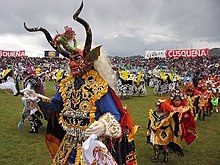| Revision as of 22:13, 3 September 2009 edit68.100.209.15 (talk)No edit summary← Previous edit | Revision as of 03:06, 4 September 2009 edit undoUnknown Lupus (talk | contribs)124 edits Undid revision 311734667 by 68.100.209.15 (talk)Next edit → | ||
| Line 3: | Line 3: | ||
| ].]] | ].]] | ||
| The '''Diablada''' is a ] ] that was created in the Andean ] but holds ] origins in ]. The dance is practised throughout the ], and is an important part of the cultural festivities of the nations of ], ], and ]. The dance stands prominent during the ] in Peru, the ] in Bolivia, and the ] in Chile. However, the dance is also practiced in ], ] and ]. | |||
| One of the most authentic carnivals in South America is La Diablada carnival, which takes place in the city of Oruro, in central Bolivia. The carnival is being celebrated in honor of the Saint patroness of the miners - Virgen de Socavon (the tunnel's virgin). | |||
| The oldest ''Diablada'' is recorded to have taken place on ], ], in the area of present-day Peru. In the XVI century, ] missionaries spread the '']'', a dramatic representation of the mystery of the ], in the ], beginning in the city of ]. During the evangelism of the native ] people of Juli, the Jesuits made a representation of the ] that concluded with the victory of the ], which represented good. Due to the mixture of cultures that took place in this city, it was known as the "little ] of America" and the "]'s Rome". | |||
| The carnival is celebrated in a parade of over 50 dance groups that dance, play and sing over a 5 km long course. The groups dress up as demons, Satans, Incas and Spanish conquerors. The parade is celebrated every day from morning until late night (18 hours a day). | |||
| The carnival takes place every year in parallel to the carnival in Brazil, and is a great option for those who are not interested in visiting the carnival in Brazil or can not make it there. The costumes in the Oruro carnaval are less impressive than the ones in Rio, but many view this carnival as much more authentic. | |||
| Since Oruro doesn't have a lot of accommodation to offer, and since the city is full of visitors that arrive from all over Bolivia, it is recommended to make reservation for accommodation well in advance or to arrive with a tent. | |||
| The only disadvantage of the carnival of Oruro is the love of the locals for water fights. It is an impossible mission to stay dry during the carnaval, and it is especially hard for those who are carrying cameras (though it is still feasible to take photos during the carnaval). | |||
| The great advantage of the carnival is that after the first day the viewers can choose to join one of the Tourpes and dance with it along the way of the parade. | |||
| ==Miss universe dispute== | ==Miss universe dispute== | ||
Revision as of 03:06, 4 September 2009


The Diablada is a South American dance that was created in the Andean Altiplano but holds auto sacramental origins in Spain. The dance is practised throughout the Andean region, and is an important part of the cultural festivities of the nations of Peru, Bolivia, and Chile. The dance stands prominent during the Fiesta de la Candelaria in Peru, the Carnaval de Oruro in Bolivia, and the Fiesta de la Tirana in Chile. However, the dance is also practiced in Venezuela, Ecuador and Panama.
The oldest Diablada is recorded to have taken place on Juli, Puno, in the area of present-day Peru. In the XVI century, Jesuit missionaries spread the autos sacramentales, a dramatic representation of the mystery of the Eucharist, in the Viceroyalty of Peru, beginning in the city of Juli. During the evangelism of the native Lupacas people of Juli, the Jesuits made a representation of the seven deadly sins that concluded with the victory of the angel, which represented good. Due to the mixture of cultures that took place in this city, it was known as the "little Rome of America" and the "Aymara's Rome".
Miss universe dispute
In August 1 of 2009 Bolivian officials stated that it could present a legal appeal to the organizers of Miss Universe due to the planned use of a typical Diablada wear by the Peruvian candidate Karen Schwarz. Pablo Groux, Bolivian minister of Culture, said that any use of the wear by Scharwz in the content would be an unlawful appropriation of Bolivian heritage and have menaced to bring the case to the International Court of Justice. El Comercio, a Peruvian newspaper, have mentioned that this is not the first time the diablada wear is shown in the contest and that it was María Josefa Isensee, a Chilean, that first used it in the Miss Universe contest. Peruvian foreign minister José Antonio García Belaúnde said that since the Diablada dress is of indigenous Aymara origin it can not be considered an exclusive of any of the particular countries where the Aymara live.
See Also
References
- Perú y Bolivia incluyen a Chile en disputa por traje de Diablada El Mercurio
- Bolivia rechaza que representante peruana en Miss Universo use traje de la "Diablada" El Mercurio
External links
This dance-related article is a stub. You can help Misplaced Pages by expanding it. |